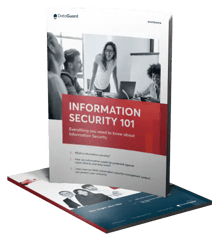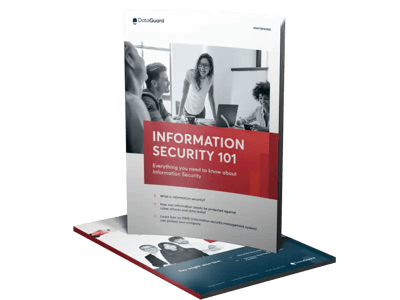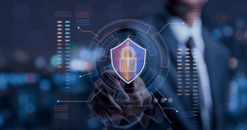Consumer data collection continues to be a significant part of an organisation's marketing efforts across the world. At the same time, this data has the potential to be exposed to risks like data breaches, unauthorised access, or accidental misplacements – leading to severe legal penalties and fines.
How can you avoid this? In this article, learn about why information security is important, how organisations can keep their data secure, the benefits of doing so, and the types of data security threats they could face.
In this article
- What is information security?
- What are the types of confidential information?
- Why is information security so important?
- What are the potential consequences of a lack of information security?
- What are the types of information security threats?
- What are the advantages and disadvantages of implementing information security?
- What are the next steps in working with information security?
- What to consider if you are just starting out with information security
- Strengthen your information security with DataGuard
What is information security?
To keep data safe, organisations employ a variety of methods and techniques that are referred to together as "Information Security" (InfoSec). Policy settings that prohibit unwanted access to commercial or personal information are included in this category.
Information security is one of the fastest-growing and most diverse topics, including everything from network and infrastructure security to auditing and testing. In general, there are two types of information: physical and digital. Information can be anything from your personal information to your social media profile, cell phone data, biometrics, and so on.
As a result, InfoSec comprises a wide variety of academic topics, including but not limited to:
- Cryptography
- Mobile computing
- Cyber forensics
- Online social media
In today's world, people no longer keep vital documents in safes or employ security guards to protect this information. Digital data is expected to be more frequently secured. Therefore, organisations must hire information security experts to establish protected zones. These zones include everything from virtual safes, installing antivirus security software and encrypting digital information using cryptographic methods.
So, what are the types of critical information that need protecting?
What are the types of confidential information?
Apart from physical and digital, information is also categorised as public or confidential. Public information is accessible to the general public, while confidential information is accessible only to certain individuals. In general, confidential information has five categories.
Personal information
Detailed information about a person, such as their full name, passport number, phone number and more. Customers' and employees' personal information is referred to as "personal data."
Trade secret
Information on the organisation’s work, such as its technology, management procedures, and clientele base. The organisation may suffer financial harm if this information is made public. The corporation defines trade secrets, and the public is not privy to all of the company's secrets. Furthermore, not all information can be protected as a trade secret, like the names of the organisation’s founders or working conditions.
Professional secret
Medical, notarial, lawyer and other forms of professional secrets are all included in this category. A variety of laws governs it at once.
Official secret
Tax and registry offices, for example, have access to this information. Typically, this information is kept by the government. It is their responsibility to keep it safe and only provide it to you if you ask for it.
State secret
Important and closely guarded information that the government protects.
Why is information security so important?
Weak data security can lead to losing or stealing key information, creating a poor customer experience and reputational harm. Data breaches, fraud, and cyber-security attacks are all becoming more common as people become more reliant on technology.
As organisations strive for ISO 27001 certification, they're not just bolstering their information security; they're also setting the stage for seamless alignment with NIS2 standards. Here are a few important reasons for organisations to implement information security systems.
Information security threats are very common
Threats to information security are increasingly common. Worms, viruses, data extortion, intellectual property theft, identity theft, and theft of physical equipment are among them. A common type of threat is something called ransomware. This is when a hacker prevents access to information or threatens to expose it until they are paid a set amount.
The cost of a data breach
A security breach can take various forms, all of which can be costly. If you do not comply with the GDPR in the UK and EU, you may face fines of up to £17.5 million (€20 million) or 4% of your global revenue (whichever is higher), or temporary or permanent limits on processing and collecting data.
State-sponsored hackers
Governments finance hacker groups to disrupt or meddle with other countries' affairs. In one of the greatest cyber-attacks ever, Russian-sponsored hackers hacked thousands of US organisations over 8-9 months in 2020. Other international organisations, such as NATO and the European Parliament, were also impacted.
IoT - Internet of Things
The Internet of Things (IoT) is a vast network of physical objects that have been equipped with software and sensors that allow them to connect to the Internet and other devices. Smartphones, smartwatches, and smart houses are examples of IoT consumer items that can control everything from air conditioning to door locks from a single device. Many of these devices are vulnerable to cyber-attacks.
Cyberattacks increase during challenging times
Information security is critical at all times, but especially during times of emergency. A good example is the global epidemic. In 2020, cyberattacks doubled. Hospitals and pharmaceutical companies, for example, were badly affected.
Many organisations have also been harmed by the widespread adoption of remote working, which leaves them more vulnerable to attack by hackers. No one can predict a crisis, but any organisation dealing with data should be prepared for the worst.
Additionally, providing secure and reliable equipment to remote workers becomes crucial in ensuring a robust defence against potential cybersecurity threats. Additionally, providing secure and reliable equipment to remote workers becomes crucial in ensuring a robust defence against potential cybersecurity threats.
Cyberattacks are getting more sophisticated
Cyberattacks are becoming more sophisticated, making information security even more important and relevant. Hackers are getting better, but they also don't have to put in as much effort to be effective because of the advancements in technology.
Also, they've become more organised, forming communities and exchanging information. The size of the groups do not matter, as it is possible even for a small group of hackers to inflict significant harm on numerous networks at the same time.
When organisations begin to establish information security strategies, the above risks must always be kept in mind so that they can be adequately prepared to face them if ever needed.
What are the potential consequences of a lack of information security?
Lack of proper information security can lead to a number of problems. Typically, organisations with weak InfoSec may face:
Operational disruptions
Black hat hackers commonly demand ransom money when they enter and access an organisation's systems and data. The affected company's entire IT infrastructure and business vital systems are usually shut down to isolate the damage, investigate, and restore normal operation. Companies without basic disaster recovery processes, such as regularly updated backups, may take weeks or months to recover all lost data.
Legal ramifications
Data breaches involving clients, partners, or prospects might lead to lawsuits. These lawsuits have been widely reported in business and technology news worldwide in recent years. These lawsuits affect an organisation in the following ways:
- Lowering trust and confidence levels of customers
- Featuring in adverse media
- Reducing the attractiveness of the company in the eyes of prospective clients
- Incurring hefty and unplanned legal fees
Financial loss
The financial impact of cybercrime varies depending on the type. These are the key considerations: loss of revenue; legal fees; fines; efforts to contain an attack or breach; client compensation; and possibly share price decline (especially if the company is publicly traded). The long-term implications of data breaches often include client abandonment and decreased sales.
What are the types of information security threats?
To combat the main threats to data security, organisations must emphasise the importance of data security and take action. Below are the top six threats in InfoSec:
| Security threat | Description |
| Social engineering | Social attacks occur when criminals mislead their targets into taking certain actions, such as ignoring security measures or revealing secret information, in order to get access to sensitive data. One of the most common examples is a phishing attack. |
| Third-party exposure | Third-party providers must be trusted to handle sensitive information securely and confidentially. If a vendor has a data breach, the principal firm controlling the customer connection is still liable for the data loss. Vendors must treat information security as seriously as their own company does, or risk losing business. |
| Patch Management | Any vulnerability can be exploited in a cyberattack. One area in which organisations must be vigilant is patch management. These organisations must ensure that their software is always updated to the most recent version in order to minimise the risk of attack. |
| Ransomware | If a ransomware assault infects your network, it locks up your files and demands a fee before releasing them. The ransom attack can result in financial losses, reputational harm, lost productivity, and data loss. |
| Malware | Malware is harmful software that is designed to harm a company's software, data, and information, as well as its capacity to conduct business. |
| Overall data vulnerabilities | Cyber-attacks can exploit any system flaw. Older technology, insecure networks, and human mistakes due to a lack of employee training are also risks. Employees using personal devices for work that are not properly protected are another source of risk. A thoughtful risk assessment plan can help you estimate your company's potential exposure. |
What are the advantages and disadvantages of implementing information security?
The primary goal of information security is to balance the protection of data's confidentiality, integrity, and availability (also known as the CIA triad) while focusing on effective policy execution without compromising organisation productivity.
Here's a summary of advantages and disadvantages an organisation may face when implementing information security.
| Advantages | Disadvantages |
| As technology advances, the number of crimes committed increases – making it worthwhile to utilise information security. | Because technology is constantly evolving, consumers must purchase enhanced information security on a regular basis. |
| It protects sensitive personal information from falling into the wrong hands. | Due to the constant evolution of technology, the data may not be 100% secured. |
| It keeps top-secret information and capabilities out of the hands of terrorists and adversary nations for the government. | If a user overlooks a single region that has to be safeguarded, the entire system could be jeopardised. |
| Information security safeguards users' sensitive data while it is in use and while it is being saved. | It can be incredibly difficult to understand, and users may not fully comprehend what they are dealing with. |
Information security should not be a difficulty or a barrier when doing business. In fact, security is a competitive advantage, and if your organisation should treat it as such, investing in information security will protect you and help you grow faster.
What are the next steps in working with information security?
As of now, increased readiness is now the subject of new legislation. These outline that organisations that provide critical services to society improve their security measures.
A common measure is implementing an Information Security Management System (ISMS) and ensuring that it is ISO 27001 certified. For information on complying with the ISO 27001 certification, read our essential guide to ISO 27001.
What to consider if you are just starting out with information security
Figuring out where to begin with information security in an organisation can be a challenge. To help you get started, here are a few pointers.
Information Security means more than technology
Because so much data is now stored and processed through IT systems, the terms "information security" and "IT security" are often used interchangeably - however if this is technically not correct. People and processes, on the other hand, must be incorporated if the project is to be successful. Stable defence requires systematic and ongoing efforts based on resources' strengths as well as weaknesses' threats and dangers.
Infosec has to be linked to your organisation's risk management
All of your security activities must be predicated on how the risks in your environment are being controlled. The same rules apply to information security concerns as they do to any other risk.
Ensure that management takes responsibility
Management is always responsible for security work since only they have the authority to decide not to address security threats. In light of the escalating pace of cyber-attacks, any organisation that does not invest in information security is enduring a financial risk.
Review procedures and processes
There are no boundaries when it comes to ensuring the security of an organisation's operations and information, whether it is stored on a computer or a piece of paper. Begin laying out routines and processes, who has access to information and systems, and the level of your security thinking.
Develop a security policy
Security policies and other regulatory documents serve as the official structure for your activity in InfoSec. It is up to you to detail what needs to be available, what needs to be done, and how it should be done.
Strengthen your information security with DataGuard
Starting with best practices and expanding from there is a great strategy to develop and manage information security. The points we have covered so far are crucial, but they are only a foundation. Protecting your organisation's data and keeping your organisational and client data safe is critical to the strength and growth of your organisation.
Information security is an essential practice, and having the correct technology and policies in place will assist you in protecting your organisation in the long run.
With DataGuard's ISO 27001 certification solution, industry specialists will guide you through the information security procedures. Our tools and services make it simple to comply with both UK and EU GDPR regulations, allowing you to position your organisation for success.
Need help developing your organisation's information security program? Book an appointment with us today.












